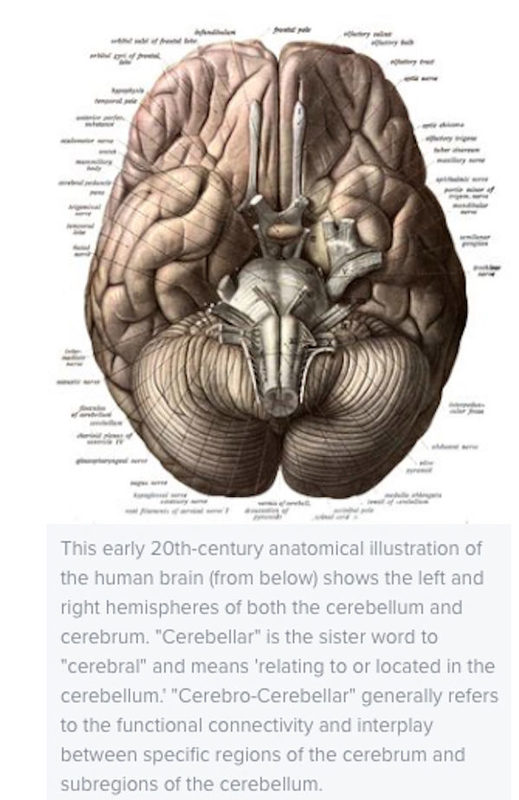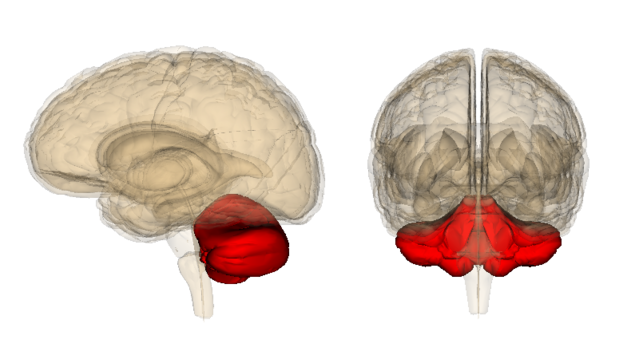
© Wikipedia
As an evidence-based journalist who follows newsworthy trends in
neuroscience, I've been keeping an eye on the rising popularity of the cerebellum (Latin for "little brain"). In recent weeks, this often-overlooked subcortical brain region has skyrocketed to buzzword status. I have a hunch "cerebellum" might be on the verge of becoming a household word such as "amygdala," "hippocampus," and "prefrontal cortex" that have made the rare leap from the esoteric lexicon of neuroscience to everyday terminology.
For the past decade, I've been trying (without much success) to make the term "cerebellar" a household word by putting the importance of cerebrum-cerebellum interplay in the spotlight. In the list below, I present three key ingredients that I speculate may have created a tipping point which could result in our "little brain" becoming the next big thing in neuroscience.
Before diving into a simple deconstruction of how the cerebellum became a "hot" topic in the past few weeks, there's an important caveat: This purposely short list of three factors that may be causing reportage on the cerebellum to surge is more an analysis of how media trends work in neuroscience than a comprehensive retrospective of cerebellar research.
3 Reasons Nonmotor Functions of the Human Cerebellum Are a Trending Neuroscience Topic

© Cerebellum (Latin for "little brain") in red.Source: Life Sciences Database, Wikipedia Commons
First and foremost, since the late-20th century,
Jeremy Schmahmann of Harvard Medical School's Massachusetts General Hospital has been a pioneering researcher and advocate for the cerebellum. In 1998, he published two landmark papers that put the ball in motion for other neurologists and neuroscientists to begin questioning the long-held (but inaccurate) belief that the human cerebellum was only responsible for motor functions.
Schmahmann's revolutionary
Cerebellar Cognitive Affective Syndrome (1998) and
Dysmetria of Thought (1998) hypotheses were late-20th century game-changers. Despite initial skepticism amongst his peers, throughout the early-21st century, Schmahmann has gradually convinced naysayers in the worldwide neuroscience community that the cerebellum plays an important role in both motor and nonmotor functions. In my opinion, Schmahmann's profound insights and unflagging persistence are the prime driving force that could make "cerebellum" a household term.
Please take a few minutes to watch Jeremy Schmahmann explain the resistance he initially experienced from the established neurological community when he floated his (now widely accepted) "dysmetria of thought" hypothesis which posits that the cerebellum might fine-tune our thoughts and emotions much the same way it fine-tunes the coordination of muscle movements.
2. Debunking a Neuromyth: The Cerebellum Is NOT a Motor-Function Only Brain RegionThe second reason the human cerebellum recently caught the attention of science reporters is that the "little brain" has been misunderstood for centuries. When a long-held belief about the brain is proven wrong, it creates a newsworthy neuroscience-based story. Because the cerebellum has been underestimated and wrongly considered to be solely responsible for motor functions for so long, new discoveries that the human cerebellum is actually involved in a wide range of nonmotor functions is creating well-deserved media buzz.
As part of my decades-long attempt to debunk the neuro myth that the human cerebellum is only responsible for motor functions, on October 20, 2018, I wrote a
Psychology Today blog post, "
Da Vinci Was Right: The Cerebellum Deserves More Recognition." This post traced the roots of the term "cerebellum" back to 1504 when
Leonardo da Vinci made wax castings of the brain. For 500 years, most neuroscientists strongly believed that the cerebellum had nothing to do with
cognition and was solely involved in motor functions.
On the morning of October 23, I saw a press release from the Washington University School of Medicine in St. Louis with an eye-grabbing headline,
Mind's Quality Control Center Found in Long-Ignored Brain Area: Cerebellum Checks and Corrects Thoughts, Movement. This title jumped out at me. After reading about this fascinating new research, I immediately emailed the head of WUSTL media relations to get a PDF of the upcoming paper, which was under embargo until 11 a.m. EST on October 25.
After devouring this full paper, I was too busy polishing up my own blog post,
Cerebellum Studies Challenge Ancient Notions About How We Think, about this
cutting-edge research to be listening to
Morning Edition on NPR, which reported on this new study within moments of the embargo being lifted. At the heart of this NPR story is the paper,
Spatial and Temporal Organization of the Individual Human Cerebellum, by first author,
Scott Marek, and colleagues in the
WUSTL lab of senior author,
Nico Dosenbach which was published October 25 in the journal
Neuron.
Social-reformer journalist,
Jacob Riis, used a "stonecutter" analogy when he described his determination to never give up on reporting about a seemingly unpopular topic that was failing to gain traction in the general public's consciousness. Over the years as a science-based writer, when I've given up hope that anyone will ever care about the cerebellum, Riis' words have inspired me to keep writing about this topic. He said, "When nothing seems to help, I go and look at the stonecutter hammering away at his rock, perhaps one hundred times without as much as a crack showing in it. Yet at the hundred and first blow it will split in two, and I know it was not that one blow that did it-but all that had gone on before."
Using this "stonecutter" analogy to look at the cerebellum suddenly becoming part of the neuroscience zeitgeist: it's important to note that there have obviously been countless neuroscientists around the globe who've been continuously "hammering away" at solving the many riddles of the cerebellum. These researchers are responsible for "hundreds of blows" that have led to public interest in the cerebellum finally being cracked open. That said, it seems like the latest paper by Marek et al. (2018) is the "hundred and first" blow that caused everything that's gone before regarding cerebellum to reach a tipping point that piqued the curiosity of international journalists.
3. Two National Public Radio (NPR) Reports on Cerebellar ResearchOver the past few years, a reporter from the science desk at NPR,
Jon Hamilton, has done two reports on the cerebellum that have reached millions of listeners. To the best of my knowledge, Hamilton is one of the few reporters with a massive general audience who has continuously reported on the nonmotor functions of the human cerebellum. His
Morning Edition coverage on NPR is the third reason the human cerebellum may become the next big thing in neuroscience.
NPR's flagship news magazine,
Morning Edition, has a weekly audience of nearly 15 million listeners and is the
#1 most-listened-to radio program in the United States based on weekly cumulative listenership. Having
Morning Edition report on the "little brain" is a very big deal.
The first cerebellar report from Jon Hamilton,
A Man's Incomplete Brain Reveals Cerebellum's Role In Thought And Emotion, featured an interview with Jeremy Schmahmann and aired on the March 16, 2015 edition of NPR's
Morning Edition.
The second cerebellar report by Jon Hamilton,
The Underestimated Cerebellum Gains New Respect From Brain Scientists, includes an interview with Schmahmann as well as Nico Dosenbach and Scott Marek. This report aired on the October 25, 2018 edition of NPR's
Morning Edition.
These are exciting times for state-of-the-art cerebellar research, which continues to shake things up and disrupt the neuroscience-based status quo. Google alerts about the human cerebellum as the "mind's control center" have been dinging endlessly on my smartphone for the past two weeks. In many ways, the WUSTL
paper by Marek et al. (2018) was a tipping point that has made the cerebellum a momentary media darling. Hopefully, people's curiosity about the cerebellum is sustainable.
ReferencesScott Marek, Joshua S. Siegel, Evan M. Gordon, Ryan V. Raut, Dillan J. Newbold, Mario Ortega, Timothy O. Laumann, Derek B. Miller, Annie Zheng, Katherine C. Lopez, Jeffrey J. Berg, Rebecca S. Coalson, Annie L. Nguyen, Donna Dierker, Andrew N. Van, Catherine R. Hoyt, Kathleen B. McDermott, Scott A. Norris, Joshua S. Shimony, Abraham Z. Snyder, Steven M. Nelson, Deanna M. Barch, Bradley L. Schlaggar, Marcus E. Raichle, Steven E. Petersen, Deanna J. Greene, Nico U.F. Dosenbach. "Spatial and Temporal Organization of the Individual Human Cerebellum."
Neuron (First published: October 25, 2018) DOI:
10.1016/j.neuron.2018.10.010About the author Christopher Bergland is a world-class endurance athlete, coach, author, and political activist. Author of The Athlete's Way: Sweat and the Biology of Bliss
Adorable kind ladies;
Bikinis;
The continuation of the species...
Oops, they're talking about a different 'little brain'...my bad. (Wink - emojis are missing for me now.)
R.C.